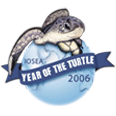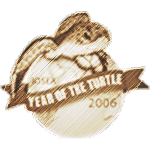Not only for dogs, 2006 is also Year of the Turtle

First posted 04:46am (Mla time) Jan 03, 2006 By Blanche Rivera Inquirer
THE United Nations has declared 2006 the Year of the Turtle in an effort to save the gentle species.
Twenty-five countries in the Indian Ocean Southeast Asian (IOSEA) region, including the Philippines, have signed a memorandum of understanding dedicating 2006 to the protection of sea turtles, known locally as pawikan.
"The conference represents a symbolic turning point and the first time the problems of marine turtles were seriously discussed among so many governments with a common commitment to take action," said Douglas Hykke, head of the UN Secretariat overseeing the implementation of the IOSEA agreement.
5 of 7 species here in RP Of the seven known species of marine turtles in the world, five are found in the Philippines: The loggerhead, leatherback, olive ridley, hawksbill and green turtle.
The Turtle Islands off the coast of Palawan are identified as among the most important conservation sites for the endangered marine turtles.
The Turtle Islands, named so because of their rare marine inhabitants, straddle the border of Malaysia and the Philippines.Of the nine islands belonging to this group, six-Boan, Taganak, Bakkungan, Lihiman, Langaan and Baguan-are managed by the Philippines while three are managed by Malaysia.
The Philippine and Malaysian governments established the Turtle Islands Heritage Park (Tihpa), declared a sanctuary for the marine turtles, in 1996. The Tihpa is jointly managed by the two countries.
The Tihpa is Southeast Asia's largest remaining nesting site for green turtles. About 80 percent of the turtle nestings in the Philippines are on the six islands, according to the World Wildlife Fund, which has been doing conservation efforts on the Turtle Islands for almost two decades.
Some 1.2 million turtle eggs have hatched on the islands over the past 15 years, but many of these ended up being sold by fishermen, according to the latest WWF case study on the Turtle Islands.
The turtle egg trade has been a source of income for people of the Turtle Islands, a sixth-class municipality relying mostly on coastal resources for livelihood.
The eggs are popular as a delicacy-with some believing it to be an aphrodisiac-and turtle shell is considered a choice material for eyeglass frames, lighters, combs and decorative items.
Southeast Asia is considered the world's biggest consumer of turtle eggs, with those from the Philippines finding their way to Hong Kong, Singapore and Brunei.
"Having survived natural hazards for millennia, sea turtles are now under severe threat from human activity," the WWF said.
The biggest threats come from dynamite fishing, indiscriminate harvesting of eggs, conversion of the sandy areas where turtles nest to resorts and other commercial facilities.
Mundita Lim, assistant director of the Protected Areas and Wildlife Bureau, said the IOSEA agreement was crucial to the protection of marine turtles because it required parallel and intergovernmental measures.
"The Philippines is a major pathway of the pawikan," Lim said. "It would be useless to protect the migratory species if the other range states do not protect them."
THE United Nations has declared 2006 the Year of the Turtle in an effort to save the gentle species.
Twenty-five countries in the Indian Ocean Southeast Asian (IOSEA) region, including the Philippines, have signed a memorandum of understanding dedicating 2006 to the protection of sea turtles, known locally as pawikan.
"The conference represents a symbolic turning point and the first time the problems of marine turtles were seriously discussed among so many governments with a common commitment to take action," said Douglas Hykke, head of the UN Secretariat overseeing the implementation of the IOSEA agreement.
5 of 7 species here in RP Of the seven known species of marine turtles in the world, five are found in the Philippines: The loggerhead, leatherback, olive ridley, hawksbill and green turtle.
The Turtle Islands off the coast of Palawan are identified as among the most important conservation sites for the endangered marine turtles.
The Turtle Islands, named so because of their rare marine inhabitants, straddle the border of Malaysia and the Philippines.Of the nine islands belonging to this group, six-Boan, Taganak, Bakkungan, Lihiman, Langaan and Baguan-are managed by the Philippines while three are managed by Malaysia.
The Philippine and Malaysian governments established the Turtle Islands Heritage Park (Tihpa), declared a sanctuary for the marine turtles, in 1996. The Tihpa is jointly managed by the two countries.
The Tihpa is Southeast Asia's largest remaining nesting site for green turtles. About 80 percent of the turtle nestings in the Philippines are on the six islands, according to the World Wildlife Fund, which has been doing conservation efforts on the Turtle Islands for almost two decades.
Some 1.2 million turtle eggs have hatched on the islands over the past 15 years, but many of these ended up being sold by fishermen, according to the latest WWF case study on the Turtle Islands.
The turtle egg trade has been a source of income for people of the Turtle Islands, a sixth-class municipality relying mostly on coastal resources for livelihood.
The eggs are popular as a delicacy-with some believing it to be an aphrodisiac-and turtle shell is considered a choice material for eyeglass frames, lighters, combs and decorative items.
Southeast Asia is considered the world's biggest consumer of turtle eggs, with those from the Philippines finding their way to Hong Kong, Singapore and Brunei.
"Having survived natural hazards for millennia, sea turtles are now under severe threat from human activity," the WWF said.
The biggest threats come from dynamite fishing, indiscriminate harvesting of eggs, conversion of the sandy areas where turtles nest to resorts and other commercial facilities.
Mundita Lim, assistant director of the Protected Areas and Wildlife Bureau, said the IOSEA agreement was crucial to the protection of marine turtles because it required parallel and intergovernmental measures.
"The Philippines is a major pathway of the pawikan," Lim said. "It would be useless to protect the migratory species if the other range states do not protect them."
















0 Comments:
Post a Comment
<< Home